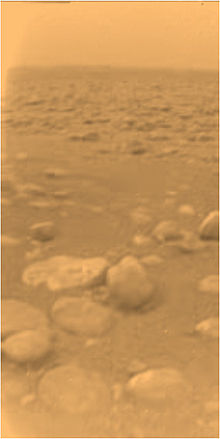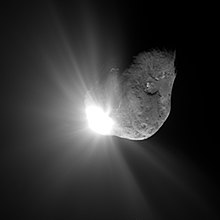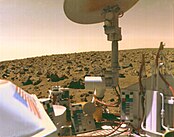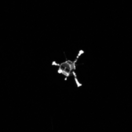Lander (spacecraft)
This articleneeds additional citations forverification.(September 2020) |
This article needs to beupdated.(August 2023) |
Alanderis aspacecraftthat descends towards, then comes to rest on the surface of anastronomical bodyother thanEarth.[1][page needed]In contrast to an impact probe, which makes ahard landingthat damages or destroys the probe upon reaching the surface, a lander makes asoft landingafter which the probe remains functional.
For bodies withatmospheres,the landing occurs afteratmospheric entry.In these cases, landers may employparachutesto slow them down enough to maintain a lowterminal velocity.In some cases, small landing rockets will be fired just before impact in order to reduce the lander's velocity. Landing may be accomplished bycontrolled descentand set down onlanding gear,with the possible addition of a post-landing attachment mechanism (such as the mechanism used byPhilae) for celestial bodies with low gravity. Some missions (for example,Luna 9andMars Pathfinder) used inflatable airbags to cushion the lander's impact rather than utilizing more traditional landing gear.
When a high-velocity impact is intentionally planned in order to study the consequences of impact, the spacecraft is called an impactor.[2]
Severalterrestrial bodieshave been subject to lander or impactor exploration. Among them are Earth'sMoon;the planetsVenus,Mars,andMercury;Saturn's moonTitan;asteroids;andcomets.
Landers[edit]
Lunar[edit]


Beginning withLuna 2in 1959, the first few spacecraft to reach the lunar surface were impactors, not landers. They were part of theSovietLuna programor the AmericanRanger program.
In 1966, the SovietLuna 9became the first spacecraft to achieve a lunar soft landing and to transmit photographic data to Earth. The AmericanSurveyor program(1966–1968) was designed to determine where Apollo could land safely. As a result, these robotic missions required soft landers to sample the lunar soil and determine the thickness of the dust layer, which was unknown before Surveyor.
The U.S.-crewedApollo Lunar Modules(1969–1972) withrovers(1971–1972) and late Soviet large robotic landers (1969–),Lunokhods(1970–1973) andsample return missions(1970–1976) used a rocket descent engine for a soft landing of astronauts and lunar rovers on the Moon.
The ChineseChang'e 3mission and itsYutu('Jade Rabbit') rover landed on 14 December 2013. In 2019, China'sChang'e 4mission successfully landed theYutu-2rover on thefar side of the Moon.[3]Chang'e 5andChang'e 6are designed to be sample return missions.[4]Chang'e 5 is currently scheduled for 2020, while Chang'e 6 is planned for 2023[5]or 2024.[4]Chang'e 5mission landed on the Moon on 1 December 2020, China completed theChang'e 5mission on 16 December 2020 with the return of approximately 2 kilograms of lunar sample.
On 6 September 2019, the landerVikramonChandrayaan-2,attempting to land on the lunar south polarregion. Due to software glitch, it lost contact and crashed moments before landing.[6][7]
About 4 years later, on 23 August 2023, the landerVikramonChandrayaan-3successfully touched down on the lunar south pole, close to the crater Manzinus U. This made it the first lander to soft land at the south pole of the Moon.[8][9]
Japan became the fifth country to land a lunar probe on 19 January 2024, by successfully landing itsSLIM lander.
On 22 February 2024, Intuitive Machine'sOdysseussuccessfully landed on the Moon after taking off on a SpaceXFalcon 9.This was the first successful landing of aprivately owned spacecrafton the Moon.[10][11]
China sentChang'e 6on 3 May, which conducted the first lunar sample return from thefar side of the Moon.[12]This is China's second lunar sample return mission, the first being achieved byChang'e 5from the lunar near side in 2020.[13]
Venus[edit]
The SovietVenera programincluded a number ofVenuslanders, some of which were crushed during descent much as Galileo's Jupiter "lander" and others which successfully touched down.Venera 3in 1966 andVenera 7in 1970 became the first impact and soft landing on Venus respectively. The SovietVega programalso placed two balloons in the Venusian atmosphere in 1985, which were the first aerial tools on other planets.
Mars[edit]

The Soviet Union'sMars 1962Bbecame the first mission intended to impact on Mars in 1962. In 1971, the lander of theMars 3probe conducted the firstsoft landingon Mars, but communication was lost within a minute after touchdown, which occurred during one of the worst global dust storms since the beginning of telescopic observations of the Red Planet. Three other landers,Mars 2in 1971 andMars 5andMars 6in 1973, either crashed or failed to even enter the planet's atmosphere. All four landers used an aeroshell-like heat shield duringatmospheric entry.Mars 2 and Mars 3 landers carried the first small skis-walkingMars rovers,PrOP-M,that did not work on the planet.
The Soviet Union planned the heavyMarsokhodMars 4NMmission in 1973 and theMars sample returnMars 5NMmission in 1975, but neither occurred due to needing theN1 super-launcherthat was never flown successfully. A double-launching SovietMars 5M(Mars-79) sample return mission was planned for 1979 but cancelled due to complexity and technical problems.
NASA'sViking 1andViking 2were launched respectively in August and September 1975, each comprising an orbiter vehicle and a lander.Viking 1landed in July 1976Viking 2in September 1976. TheViking programrovers were the first successful, functioning Mars landers. The mission ended in May 1983, after both landers had stopped working.
Mars 96was the first complex post-Soviet Russian mission with an orbiter, lander, penetrators. Planned for 1996, it failed at launch. A planned repeat of this mission, Mars 98, was cancelled due to lack of funding.
The U.S.Mars Pathfinderwas launched in December 1996 and released the first acting rover on Mars,Sojourner,in July 1997. It worked until September 1997.
TheMars Polar Landerceased communication on 3 December 1999 prior to reaching the surface and is presumed to have crashed.
The EuropeanBeagle 2lander deployed successfully from theMars Expressspacecraft but the signal confirming a landing which should have come on 25 December 2003 was not received. No communication was ever established andBeagle 2was declared lost on 6 February 2004. The proposed 2009 BritishBeagle 3lander mission to search for life, past or present, was not adopted.
The AmericanMars Exploration RoversSpiritandOpportunitywere launched in June and July 2003. They reached the Martian surface in January 2004 using landers featuring airbags and parachutes to soften impact.Spiritceased functioning in 2010, more than five years past its design lifetime.[14]As of 13 February 2019,Opportunitywas declared effectively dead, having exceeded its three-month design lifetime by well over a decade.[15]
The U.S. spacecraftPhoenixsuccessfully achieved soft landing on the surface of Mars on 25 May 2008, using a combination of parachutes and rocket descent engines.
Mars Science Laboratory,which carried the roverCuriosity,was launched byNASAon 26 November 2011. It landed in theAeolis Palusregion ofGale Crateron Mars on 6 August 2012.
China launched theTianwen-1mission, on 23 July 2020. It includes an orbiter, a lander and a 240 kilograms rover. The orbiter was placed into orbit on 10 February 2021. TheZhurongsuccessfully soft landed on 14 May 2021 and deployed on 22 May 2021.

Martian moons[edit]
While several flybys conducted by Mars orbiting probes have provided images and other data about the Martian moonsPhobosandDeimos,only few of them intended to land on the surface of these satellites. Two probes under the SovietPhobos programwere successfully launched in 1988, but in 1989 the intended landings on Phobos and Deimos were not conducted due to failures in the spacecraft system. The post-Soviet RussianFobos-Gruntprobe was an intended sample return mission to Phobos in 2012 but failed after launch in 2011.
In 2007European Space AgencyandEADS Astriumproposed and developed the mission to Phobos to 2016 with lander and sample return, but it stayed as a project. Since 2007 theCanadian Space Agencyhas considered a mission to Phobos called Phobos Reconnaissance and International Mars Exploration (PRIME), which would include an orbiter and lander. Recent proposals include a 2008NASA Glenn Research CenterPhobos and Deimos sample return mission, the 2013Phobos Surveyor,and theOSIRIS-REx IImission concept.
TheJapanese Aerospace Exploration Agency(JAXA) plans to launch theMartian Moons Exploration(MMX) mission in 2024, a sample return mission targeting Phobos.[16]MMX will land and collect samples from Phobos multiple times, along with deploying a rover jointly developed byCNESand theGerman Aerospace Center(DLR).[17]By using a corer sampling mechanism, the spacecraft aims to retrieve a minimum of 10g of samples. MMX will return to Earth in 2029.[18]
Titan[edit]

TheHuygensprobe, carried toSaturn'smoonTitan byCassini,was specifically designed to survive landing on land or on liquid. It was thoroughly drop-tested to make sure it could withstand impact and continue functioning for at least three minutes. However, due to the low-speed impact, it continued providing data for more than two hours after it landed. The landing on Titan in 2005 was the first landing on the planet's satellites outside the Moon.
The proposed U.S.Titan Mare Explorer(TiME) mission considered a lander that would splash down in a lake in Titan's northern hemisphere and float on the surface of the lake for few months. Spain's proposedTitan Lake In-situ Sampling Propelled Explorer(TALISE) mission is similar to the TiME lander but has its own propulsion system for controlling shipping.
Comets and asteroids[edit]
Vesta,the multi-aimed Soviet mission, was developed in cooperation with European countries for realization in 1991–1994 but canceled due to the Soviet Union disbanding. It included a flyby of Mars, whereVestawould deliver anaerostat(balloon or airship) and small landers or penetrators, followed by flybys ofCeresor4 Vestaand some otherasteroidswith the impact of a large penetrator on one of them.[clarification needed]
The first landing on asmall Solar System body(an object in the Solar System that is not a moon, planet, or dwarf planet) was performed in 2001 by the probeNEAR Shoemakerat asteroid433 Erosdespite the fact that NEAR was not originally designed to be capable of landing.
JapaneseHayabusaprobe made several attempts to land on25143 Itokawain 2005 with mixed success, including a failed attempt to deploy arover.Designed to rendezvous and land on a low-gravity body,Hayabusabecame the second spacecraft to land on an asteroid, and in 2010 the first sample return mission from an asteroid.
TheRosettaprobe, launched 2 March 2004, put the first robotic landerPhilaeon the cometChuryumov–Gerasimenkoon 12 November 2014. Due to the extremely low gravity of such bodies, the landing system included a harpoon launcher intended to anchor a cable in the comet's surface and pull the lander down.
JAXAlaunched theHayabusa2asteroid space probe in 2014 to deliver several landing parts (including Minerva II and German Mobile Asteroid Surface Scout (MASCOT) landers and a Small Carry-on Impactor (SCI) penetrator) in 2018–2019 to return samples to Earth by 2020.
TheChinese Space Agencyis designing a sample retrieval mission from Ceres that would take place during the 2020s.[19]
Mercury[edit]
Launched in October 2018 and expected to reach Mercury in December 2025,ESA'sBepiColombomission to Mercury was originally designed to include theMercury Surface Element(MSE). The lander would have carried a 7 kg payload consisting of an imaging system (a descent camera and a surface camera), a heat flow and physical properties package, anAlpha particleX-ray spectrometer,amagnetometer,aseismometer,a soil penetrating device (mole), and a micro-rover. The MSE aspect of the mission was cancelled in 2003 due to budgetary constraints.[20]
Moons of Jupiter[edit]
A fewJupiterprobes provide many images and other data about its moons. Some proposed missions with landing on Jupiter's moons were canceled or not adopted. The small nuclear-poweredEuropalander was proposed as part of NASA'sJupiter Icy Moons Orbiter(JIMO) mission that was canceled in 2006.
ESA launched theJupiter Icy Moon Explorer(JUICE) mission in 2023. In addition, NASA offered the ESA the opportunity to design a lander or impactor to fly alongside NASA's proposed orbiter in theEuropa Clippermission planned for 2025. As Europa is hypothesized to havewater beneath its icy surface,missions are sent to investigate itshabitabilityand assess itsastrobiologicalpotential by confirming the existence of water on the moon and determining the water's characteristics.
Impactors[edit]

Deep Space 2[edit]
TheDeep Space 2impactor probe was to be the first spacecraft to penetrate below the surface of another planet. However, the mission failed with the loss of its mother ship,Mars Polar Lander,which lost communication with Earth during entry into Mars' atmosphere on 3 December 1999.
Deep Impact[edit]
CometTempel 1was visited by NASA'sDeep Impactprobe on 4 July 2005. Theimpact craterformed was approximately 200m wide and 30–50m deep, and scientists detected the presence ofsilicates,carbonates,smectite,amorphous carbonandpolycyclic aromatic hydrocarbons.[21][22]
Moon Impact Probe[edit]
The Moon Impact Probe (MIP) developed by theIndian Space Research Organisation(ISRO), India's national space agency, was alunarprobe that was released on 14 November 2008 by ISRO'sChandrayaan-1lunarremote sensingorbiter. Chandrayaan-1 was launched on 22 October 2008. It led to the discovery of thepresence of water on the Moon.[23][24]
LCROSS[edit]
The Lunar Crater Observation and Sensing Satellite (LCROSS) was arobotic spacecraftoperated byNASAto perform a lower-cost means of determining the nature ofhydrogendetected at the polar regions of theMoon.[25]The main LCROSS mission objective was to explore the presence of water ice in a permanently shadowed crater near a lunar polar region.[26]LCROSS was launched together with theLunar Reconnaissance Orbiter(LRO) on 18 June 2009, as part of the sharedLunar Precursor Robotic Program.LCROSS was designed to collect and relay data from the impact and debris plume resulting from the launch vehicle's spentCentaurupper rocket stage striking the craterCabeusnear the south pole of the Moon. Centaur impacted successfully on 9 October 2009, at 11:31UTC.The "shepherding spacecraft" (carrying the LCROSS mission payload)[27]descended through Centaur's plume of debris, and collected and relayed data before impacting six minutes later at 11:37 UTC. The project was successful in discovering water in Cabeus.[28]
MESSENGER[edit]
The NASAMESSENGER(Mercury Surface, Space Environment, Geochemistry, and Ranging) mission to Mercury launched on 3 August 2004 and entered orbit around the planet on 18 March 2011.[29]Following a mapping mission,MESSENGERwas directed to impact Mercury's surface on 30 April 2015. The spacecraft's impact with Mercury occurred near 3:26pm EDT on 30 April 2015, leaving a crater estimated to be 16m in diameter.[30][31]
AIDA[edit]
The ESA'sAIDAmission concept would investigate the effects of impact crashing a spacecraft into an asteroid. TheDARTspacecraft impacted asteroid65803 Didymos's moonDimorphosin 2022, and the Hera spacecraft will arrive in 2027 to investigate the effects of the impact.[32]
See also[edit]
- List of artificial objects on the Moon
- List of artificial objects on Mars
- List of artificial objects on Venus
References[edit]
- ^Ball, Andrew; Garry, James; Lorenz, Ralph; Kerzhanovich, Viktor (May 2007).Planetary Landers and Entry Probes.Cambridge University Press.Bibcode:2007plep.book.....B.ISBN978-0-521-82002-8.
- ^Davis, Phil; Munsell, Kirk (23 January 2009)."Technology – Impactor – The Plan".Deep Impact Legacy Site (archive).NASA/JPL. Archived fromthe originalon 26 April 2009.Retrieved22 April2009.
- ^Barbosa, Rui C. (3 January 2019)."China lands Chang'e-4 mission on the far side of the Moon".Archivedfrom the original on 19 August 2020.Retrieved18 August2020.
- ^abWilliams, David R. (12 December 2019)."Future Chinese Lunar Missions".NASA Goddard Space Flight Center.Archivedfrom the original on 1 April 2020.
- ^Pascale, Bresson; Sart, Raphaël."State visit of President Macron to China – In 2023, Chang'e 6 will deploy the French DORN instrument on the Moon to study the lunar exosphere"(PDF)(Press release).CNES.Archived(PDF)from the original on 19 August 2020.Retrieved18 August2020.
- ^"India has found its Vikram lander after it crashed into the moon's surface".MIT Technology Review.Retrieved22 August2023.
- ^"Vikram lander located on lunar surface, wasn't a soft landing: Isro".The Times of India.8 September 2019.ISSN0971-8257.Retrieved22 August2023.
- ^Jones, Andrew (23 August 2023)."Chandrayaan-3: India becomes fourth country to land on the moon".SpaceNews.Retrieved23 August2023.
- ^"India First to Land Near Moon South Pole After Russia Fails".Bloomberg.23 August 2023.Retrieved23 August2023.
- ^SpaceX gearing up to launch Intuitive Machines private moon lander in FebruarySpace. By Mike Wall. Jan. 31, 2024. Retrieved Feb. 5, 2024.
- ^David, Emillia (22 February 2024)."Odysseus achieves the first US Moon landing since 1972".The Verge.Retrieved23 February2024.
- ^Andrew Jones [@AJ_FI] (25 April 2023)."China's Chang'e-6 sample return mission (a first ever lunar far side sample-return) is scheduled to launch in May 2024, and expected to take 53 days from launch to return module touchdown. Targeting southern area of Apollo basin (~43º S, 154º W)"(Tweet) – viaTwitter.
- ^Jones, Andrew (10 January 2024)."China's Chang'e-6 probe arrives at spaceport for first-ever lunar far side sample mission".SpaceNews.Retrieved10 January2024.
- ^"Meteorite Found on Mars Yields Clues About Planet's Past".NASA. 10 August 2009. Archived fromthe originalon 14 August 2009.Retrieved8 September2009.
- ^"Opportunity Status".NASA. Archived fromthe originalon 20 June 2014.Retrieved19 August2014.
- ^Clark, Stephen (20 November 2017)."NASA confirms contribution to Japanese-led Mars mission".Spaceflight Now.
- ^Yamakawa, Hiroshi; Le Gall, Jean-Yves; Ehrenfreund, Pascale; Dittus, Hansjörg (3 October 2018)."Joint Statement with Centre National d'Etudes Spatiales (CNES) and German Aerospace Center (DLR) regarding Martian Moons eXploration"(PDF)(Press release).JAXA.Retrieved30 October2018.
- ^Fujimoto, Masaki (11 January 2017)."JAXA's exploration of the two moons of Mars, with sample return from Phobos"(PDF).Lunar and Planetary Institute.Retrieved23 March2017.
- ^Zou Yongliao; Li Wei; Ouyang Ziyuan."China's Deep-space Exploration to 2030"(PDF).Chinese Academy of Sciences. pp. 12–13.
- ^"N° 75–2003: Critical decisions on Cosmic Vision".European Space Agency.7 November 2003.
- ^"Deep Impact: A Smashing Success".Deep Impact homepage. Archived fromthe originalon 13 July 2005.Retrieved11 May2009.
- ^Dolmetsch, Chris (3 July 2005)."Deep Impact Launches Projectile to Blow Hole in Comet (Update1)".Bloomberg. Archived fromthe originalon 11 September 2005.Retrieved11 May2009.
- ^"MIP detected water on Moon way back in June: ISRO Chairman".The Hindu.Bangalore. 25 September 2009.Retrieved9 June2013.
- ^"Chandrayaan first discovered water on moon, but..."Daily News and Analysis.Bangalore. 25 September 2009.Retrieved9 June2013.
- ^Tompkins, Paul D.; Hunt, Rusty; D'Ortenzio, Matt D.; Strong, James; Galal, Ken; Bresina, John L.; Foreman, Darin; Barber, Robert; Shirley, Mark; Munger, James; Drucker, Eric (25 April 2010).Flight Operations for the LCROSS Lunar Impactor Mission.SpaceOps 2010.NASA Technical Reports Server.hdl:2060/20100026403.
- ^"NASA – LCROSS: Mission Overview".NASA. Archived fromthe originalon 5 May 2010.Retrieved14 November2009.
- ^LRO/LCROSS Press Kit v2(PDF)(Report). NASA. June 2009.Archived(PDF)from the original on 27 October 2009.
- ^Dino, Jonas; Lunar CRater Observation and Sensing Satellite Team (13 November 2009)."LCROSS Impact Data Indicates Water on Moon".NASA.Archived fromthe originalon 6 January 2010.Retrieved14 November2009.
- ^"MESSENGER NASA's Mission to Mercury Launch Press Kit"(PDF)(Press release). NASA / JHUAPL. August 2004. Archived fromthe original(PDF)on 24 August 2007.Retrieved19 February2011.
- ^"Farewell, MESSENGER! NASA Probe Crashes Into Mercury".Space.30 April 2015.Retrieved2 May2015.
- ^"Press Release: NASA Completes MESSENGER Mission with Expected Impact on Mercury's Surface".NASA. 30 April 2015.Retrieved2 May2015.
- ^Bergin, Chris (7 January 2019)."Hera adds objectives to planetary defense test mission".NASASpaceFlight.Retrieved11 January2019.
External links[edit]
 Media related toLanders (spacecraft)at Wikimedia Commons
Media related toLanders (spacecraft)at Wikimedia Commons








